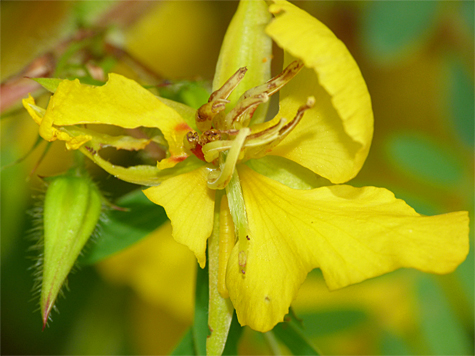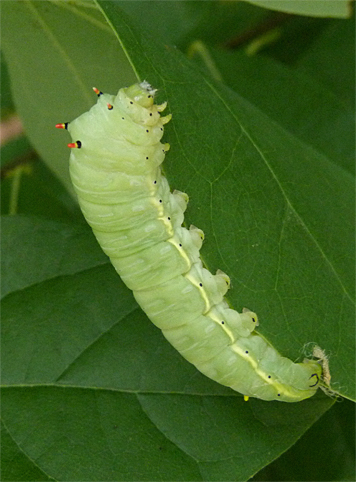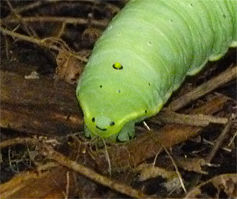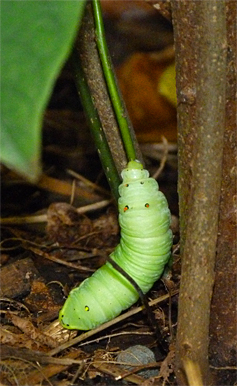It was only five days after watching a Cloudless Sulphur lay an egg on the Partridge Pea in Catch the Wind that I saw evidence of caterpillars. As I walked by the plants on Tuesday of last week I noticed one of the flowers had been partially eaten. I didn’t have my camera with me (why do I even consider walking the loop without my camera?) but the Otter Box encased iPhone that I had strapped to my belt recorded the event. I took a photo of the flower.

The next time around the loop (I walk around in circles most of the day), I spotted the little larva. It was a very tiny, not quite centimeter long, yellow caterpillar, most certainly a caterpillar of the Cloudless Sulphur. But can you believe, I still didn’t have my camera!
You can be sure that the next time I passed this spot in the loop I had my camera with me. I tried to locate the miniature flower eating caterpillar, but came up empty. I searched and searched but couldn’t find it. I took half a dozen or so close-ups of the flower and moved along.


When I examined the photos back in the lab (my office) I noticed a tube-shaped object in the center of the lower half of the picture. It was a caterpillar, the sulphur’s larva!
The next day when I was again walking the loop, this time with Summer Camp Wayne’s group of happy campers (we were identifying the various trees here at the Museum), we stopped at the Partridge Pea to have a look. The flower was gone, completely consumed by the caterpillar. After several searches we discovered that there were two caterpillars stretched out (all 8-10 mm of them) on the main stem of the plant, apparently resting after such a big meal.
Further down the path, actually while heading down the boardwalk into Explore the Wild, one of the campers, Will, shouted out that he had found something cool and wanted to show it to me. It was a caterpillar. We had just been discussing the uniquely-shaped leaves of a Tulip Poplar when the camper found a fairly large, green caterpillar on the railing of the boardwalk next to the tree.

Although I knew it was a silkmoth larva, I didn’t know which silkmoth.

The caterpillar remained with us as we continued our hike around Explore the Wild and during that time it acquired the nick-name “Happy Buns” due to the little smiley face on its posterior end. Aptly named, I’d say.
I brought the caterpillar into the Butterfly House Staff Office, and with the help of Lew, Uli, Robin Dale (visiting), and Richard, we all decided it, the caterpillar, was a Sweetbay Silkmoth.
Most caterpillars have some sort of setae (hairs), tentacles, or tubercles on their bodies to help protect them from predators. These projections on their bodies, if not truly harmful to any would be predator, at least make the caterpillar appear more fearsome.
In our area, there are three silkmoth caterpillars that have four tubercles on the thorax (the red spikes) and one yellowish tubercle on segment 8 of the abdomen. The three caterpillars are Promethea Moth, Tulip-tree Moth, and Sweetbay Silkmoth.

After doing a bit more research I now think our caterpillar is a Tulip-tree Moth caterpillar. First, it was found next to a Tulip Poplar. Second, the rear tubercle on a Sweetbay Silkmoth caterpillar is supposed to be three times as high as it is wide. Our caterpillar’s rear tubercle is very short. And third, the Promethea Moth caterpillar has yellow legs whereas “Happy’s” legs are the same color as his body.

The caterpillar was released into the Pavilion of the Butterfly House where the native NC species of lepidoptera reside. After a brief photo session it was placed on the ground and was last seen climbing up onto a shrub where it is presumed it will wrap itself in a leaf, spin a cocoon and pupate till next year.
The season is beginning to turn, we will see more of these large caterpillars as it continues to move towards fall. Look to the ground for their frass, then up to the trees for eaten leaves, and you might find a big silkmoth caterpillar munching away above you.
Enjoy!
Ranger Greg, this reminds me of your post about the oak caterpillars. The ones we see every year on the pin oak in my back yard emerged early as well. I don’t usually see them until August but they were out the third week of July.
I just went over my video logs from days gone by and see that although I have Pink-stripped Oakworm footage from July, I do not have footage of Orange-stripped Oakworms until August and September. They were indeed early this year.
Thanks,